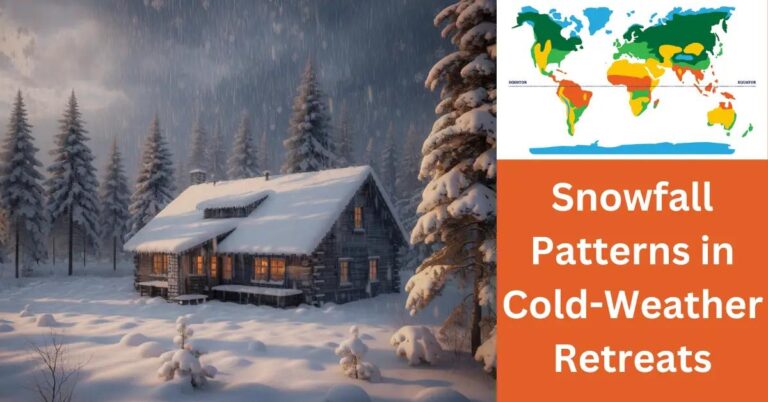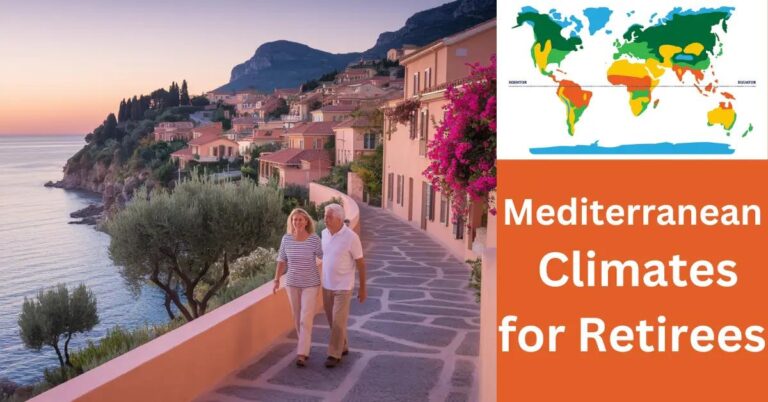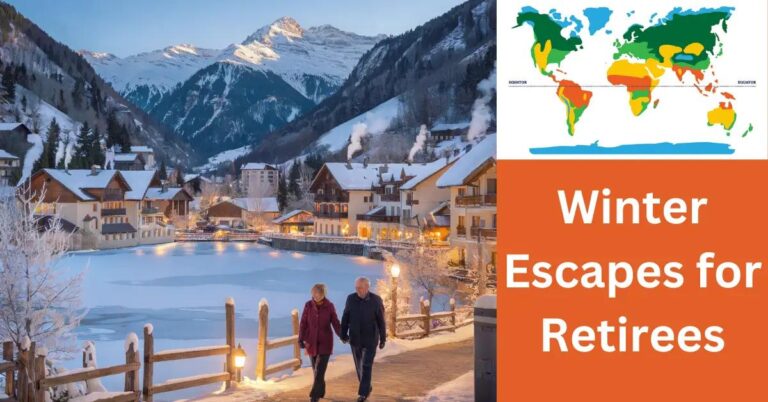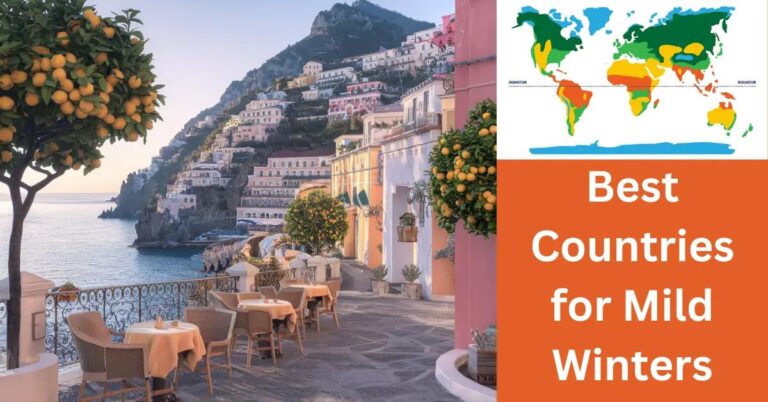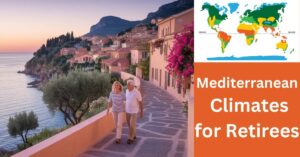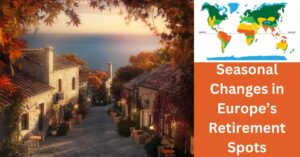TL;DR:
- Mild, stable climates like the Mediterranean are ideal for retirees in Europe, offering activities year-round.
- Portugal, especially the Algarve, and Spain, particularly Andalusia, are affordable, safe retirement spots.
- Hungary and Bulgaria offer low-cost living with cultural and natural attractions.
- Popular retiree areas include Spain, Italy, France, and Portugal due to community, culture, and English-speaking support.
- Seasonal cost fluctuations affect living costs, with prices rising in tourist seasons.
- Activities include spring hikes, autumn festivals, and language/craft classes.
- Best winter retreats: Spain’s Costa del Sol, Portugal’s Algarve, Italy’s Sicily, and Greece’s Crete for mild climates.
- Southern Europe offers the richest cultural experiences and favorable weather for retirees in winter.
Thinking of retiring in Europe? You need to know how weather shifts change the scene. From Spain to Sweden, each season brings its own flair to your golden years. Whether you seek sunshine in the South or enjoy snow in the North, seasonal weather patterns affect everything from daily routines to social events. Dive in to find which European retirement spot suits your lifestyle year-round.
How do Seasonal Weather Patterns Affect European Retirement Destinations?
When considering a place to retire, weather matters a lot. Europe has many climate options. Some places are warm and sunny all year, while others have four distinct seasons. In general, weather can change how retirees spend their days and plan activities.
What is the best climate for retirement? Mild, stable weather is usually best. It lets retirees enjoy outdoor activities without extreme heat or cold. The Mediterranean region, like Spain and Italy, offers year-round mild weather, making it ideal for many retirees.
Now, let’s compare climates. Mediterranean areas are generally warmer with more sunshine. This is perfect for beach walks and open-air cafes even in winter. Northern Europe has cooler weather, with snowy winters and mild summers. This suits those who enjoy changing seasons and cozy indoor activities.
So, what about the impact of these climates on lifestyle? Stable weather encourages a more active lifestyle. Retirees can play golf, garden, or join community events all year round in warmer areas. Conversely, Northern regions with their cool, crisp air offer beautiful seasonal changes that attract those who love autumn leaves or winter sports.
When thinking of the best places to retire in Europe for English speakers, countries like Portugal and Malta come up. They have many expatriate communities and offer mild climates. These are friendly places where many speak English, which eases the move from home.
For retirees considering Europe, adaptability is key. Adjusting to different climates might seem hard at first, but it leads to a rich, varied retirement experience. Whether you prefer the endless summer of the south or the embrace of a snowy winter, Europe offers a spot to fit each dream retirement.
What Are the Cheapest and Safest Places to Retire in Europe?
Many ask about retiring in Europe for $2000 a month. Yes, it’s possible. Europe dazzles with charm, and some spots are kind on the wallet and safe, too. Portugal, especially the Algarve, is great for affordable retirement. Apartment rentals and groceries often cost much less here compared to other countries. The Algarve charms with sunny days and beautiful beaches.
Next, let’s chat about Spain. Spain offers great value in Andalusia. It is considered the cheapest safe place in Europe. The laid-back lifestyle with delicious food and friendly folks makes settling easy. Living in smaller towns like Almeria can help stretch that budget, while still enjoying the Mediterranean vibe.
Now, consider Hungary, where Budapest is rich in history and low living costs. What makes it stand out is reliable healthcare and a vibrant culture for retirees. The balance between cost and safety is quite ideal. Many find spending Euros here doesn’t break the bank.
Also, try Bulgaria. Low costs and beautiful mountains appeal to those who love nature. Notably, cities like Sofia offer great safety. Retirees live comfortably with local food and cultural events.
Comparing costs, Portugal and Spain are a tad pricier than Hungary and Bulgaria. However, each place offers unique charms. The idea is to balance cost with comfort and safety. Choosing to retire in these countries brings not just savings but a life full of warmth and color. Make sure to explore each option fully to find the perfect spot that fits your needs and preferences, enhancing your golden years with peace and joy.
Which Are the Most Popular European Retiree Communities and Why?
When we talk about the best places to retire in Europe, a few names stand out. Portugal, Spain, Italy, and France are often at the top of the list for English speakers. These countries offer a blend of culture, good healthcare, and vibrant retiree communities.
What draws retirees to these spots? Precision suggests it’s a mix of community, culture, and comfort. Many retiree communities here have warm climates and plenty of sunshine. Activities and events tailored for older adults make these places enticing.
In Italy, the Tuscany region is a favorite for its stunning scenery. Here, you can immerse yourself in Italian culture through food and art. Tuscany’s retiree communities often organize cultural festivals and events, providing lots of immersion opportunities.
Spain attracts retirees with its lively coastal towns like Alicante. Here, retirees find beachside living along with exciting community events. Spain is also known for supporting English-speaking retirees, easing integration into local life.
Portugal’s Algarve region stands out for its beaches and friendly locals. Expat communities thrive, gathering around meals, markets, and beachside walks. Portugal also offers helpful language support for new expats.
France, particularly the Provence area, lures retirees with its peaceful countryside and rich history. There, retirees enjoy local wines, markets, and festivals. The language challenge is lessened by strong integration efforts in these places.
Many of these spots offer language and cultural classes, enhancing integration. Retiree communities often provide support networks, making the move smoother.
With the available cultural richness and support, it’s easy to see why these European spots are popular with retirees. If you’re looking for ideas on retirement and culture, explore more on [retirement spots in Europe] to start planning your future.
How Does the Seasonal Cost of Living Affect European Retirement Hotspots?
Europe’s retirement hotspots change with the seasons. You might wonder, where are the best places to retire in Europe for English speakers? Well, start by understanding the seasonal cost of living in these places.
In spring and summer, tourist crowds increase. With tourists, prices for food, rent, and fun activities often rise. This is how the “tourist seasons” make living costs jump. It can be quite a surprise for budget-conscious retirees.
By contrast, fall and winter bring fewer tourists, and that’s when deals pop up. Many locals offer discounts for long-term stays during these quieter months. This off-season time is great for those looking to stretch their euros.
Now, let’s look at strategies to manage these cost changes. Planning is key. If you choose to rent, aim for a yearly lease to avoid seasonal price hikes. Shop at local markets when prices go up in bigger stores.
Why consider moving during the off-season at all? It’s simple—retirees often find peacefulness. Crowded places become calm havens. Plus, flights are often cheaper. You save money and enjoy space.
Another thing to consider is daily expenses. Even small things like dining out vary. Many retirees eat at restaurants less during peak times. Instead, cooking at home becomes a fun, money-saving solution.
Many wonder about the best spots for English speakers. Think about areas like Portugal’s Algarve or Spain’s Costa del Sol. These places offer familiar comforts, like English-speaking communities, and affordable living during the off-seasons.
Europe is an adventure all year round. Embrace the changing costs, and you’ll find joy in every season. If you’re curious to discover more about the costs in retirement hotspots, click on this link.
What Seasonal Activities Do Retirees Enjoy in Europe?
Let’s explore the fun seasonal activities available for retirees in Europe. Retirees often enjoy the diverse options throughout the year. For example, spring brings beautiful wildflower hikes in Portugal and Spain. Walking these trails is not just good for health, but it also offers stunning views.
In autumn, Europe loves its cultural festivals, which become highlights for many retirees. From the Oktoberfest in Germany to the Hadrian’s Wall light festival in the UK, these events are exciting highlights. They carry great importance, showcasing both local tradition and heritage.
Retirees often look for places that cater to English speakers. Portugal’s Algarve and Spain’s Costa del Sol are favored spots. They boast of vibrant communities and lots of activities, perfect for those who speak English.
Beyond festivals and trails, there are various seasonal activities that cater to both outdoor lovers and indoor enthusiasts. Think of summer cycling through vineyards in France, or cozying up by a Swiss fireplace during winter. These activities suit different weather and create enjoyable experiences for retirees.
Language and craft classes present another chance for retirees to engage during different seasons. Many regions offer these classes, allowing you to speak the local tongue or learn new skills. It’s a wonderful way to meet new friends and expand personal growth.
So, Europe’s retirement hotspots offer a diverse array of activities. Each season brings its own unique charm, inviting you to enjoy it all. With so much on offer, retirees can fill their days with both learning and leisure, absorbing the rich tapestry of European life.
Which Countries Offer the Best Winter Retreats for Retirees in Europe?
When choosing a winter spot, Southern Europe shines bright. The winter sun makes it a favorite retreat for retirees searching for warm climates. Spain is often at the top for English speakers, with its vibrant culture and pleasant winters. The Costa del Sol offers endless beaches and a lively community. You can find many English speakers here, so settling in is easy.
The Algarve in Portugal is another top choice. It boasts sunny days and stunning views. Retirees love its coastal charm and friendly locals. Portugal’s mild winter climate appeals to those seeking a peaceful yet warm escape.
In Italy, Sicily is perfect for those who long for sun during the colder months. It’s not just the weather; the food, historic sites, and welcoming towns outshine others. Retirees can enjoy Sicily’s countryside for a quieter retreat.
For a more relaxed setting, consider Greece. The islands, like Crete, offer sunshine and beauty in equal measure. Crete’s beaches and mountains promise diverse scenery for exploration. The local tradition combined with winter warmth makes it a retiree favorite.
These spots have something in common: mild winters that allow active living. The climate encourages outdoor fun and easygoing adventures. Coastal retreats like these are not just about sunbathing; they open doors to deep cultural immersion.
In comparison, Northern Europe can be chilly, even frosty. While Northern Europe has its own strengths, Southern Europe’s sun is unmatched in winter comfort. Exploring the South’s countryside and coastlines enriches retirement, making it the ideal winter getaway.
Conclusion
Choosing the perfect European destination for retirement involves considering both climate and community. We discussed how seasonal weather patterns impact retiree lifestyles and highlighted cost-effective, safe locations. Popular retiree communities offer cultural immersion and support for retirees from abroad. Additionally, understanding seasonal cost changes helps manage finances wisely. Finally, whether enjoying winter sun or engaging in cultural festivals, Europe offers diverse experiences. Embrace the journey, knowing your unique retirement preferences guide the way.



